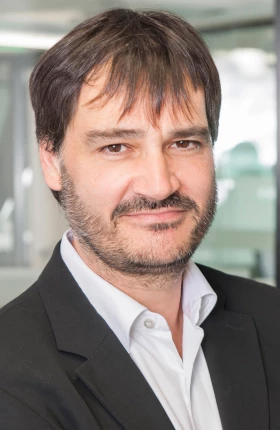Executing a digital transformation is challenging for any company, but especially for a manufacturer of products as complex as commercial aircraft. For the past several years, Airbus has been implementing a comprehensive program to digitize its design, supply-chain management, service support, manufacturing, and other functions—as well as to transform its organization and corporate culture.
As digital transformation officer for Airbus, Marc Fontaine has been leading this initiative for more than two years. A former officer in the French navy, Fontaine has served in various executive capacities at Airbus and its predecessor companies—including leading the merger that created the European aerospace consortium—for more than two decades. He has also founded several publishing and software-editing enterprises. Fontaine sat down with Loïc Mesnage, a partner at The Boston Consulting Group and managing director of the firm’s Paris office, to discuss Airbus’s progress with its digital transformation and the goals it aims to achieve.
Hello, Marc. Thanks for being with us today. What does digitization mean to the aerospace and defense industry?
We are designing, over six to ten years, a very complex product—probably the most complex product to be manufactured. And each time you get it wrong, for whatever reason, you have to modify it. And digitization will make a difference of hundreds of billions of dollars in redesign.
I believe that this type of, almost, fire-and-forget approach, when applied in this hugely valuable industry, is a source of vast opportunity if it enables you to close the loop more quickly with regard to the design and the operations of the aircraft.
What are the typical opportunities that you've seen?
Typically the opportunities involve re-creating digital continuity. When you look at the data across the supply chain and down to the operations level for each aircraft, you start to visualize larger patterns that you can fix much more easily than if you address discrete issues in piecemeal fashion. Otherwise, the silos of the industry prevent you from seeing these patterns.
For example, in our factories, merging the data of 14 SAP systems allowed us to reduce nonquality on the ramp-up by up to 30%. By interacting with airlines and by merging data from the aircraft in operation together with our knowledge in customer support and services, and with Airbus’s engineering database, we reduced the time required to fix fuel pumps on an A380—what we call “time to get a fix”—from 24 months to two weeks.
The steps we’ve taken toward data integration and data utilization have already begun unleashing incredible potential. On top of that, you have the potential to add intelligence through analytics and machine learning, to help people focus on doing their jobs and applying their knowledge, rather than spending much of their time simply gathering information.
How did you get started on this journey?
Probably the starting point was a series of exploratory visits in Silicon Valley. We were also affected by new entrants, like SpaceX in the space business and in UAVs. Not because we were always engaged in direct competition, but because the new entrants were starting to enter a new dimension. The range of cost was absolutely staggering, and the innovation potential of these companies was very impressive. Also, the introduction of complex innovations close to our business led us to question our own methodologies.
What, in your opinion, has been Airbus’s most amazing accomplishment in digital?
Understanding the power of data integration led us to build a data lake for Airbus. And now, for the industry, we have the Skywise platform, where we convinced ourselves through pragmatic, use-case-driven implementation that the technology was ready for us to leverage the incredible amount of data that we have—in our factories and engineering departments, and in service aircraft, and on board the aircraft, and in the supply chain—to resolve use cases.
Convincing ourselves that the data lake was possible—that it was secure and governable, and that we could even share it with other parties—was a true revolution. For us, as a big company, it was also the answer to a deep contradiction that we've been trying to resolve for decades, which is how to be big and nimble, how to empower teams without relinquishing control.
The fact that people can act at the proper level, concurrently rather than sequentially, in using the same data—the same proof point—across functions and across the business boundaries of the company with suppliers and customers has proved to be the crucial factor in curing the plague of silos between engineering, manufacturing engineering, manufacturing services, customers, and suppliers. So the biggest achievement for us was deploying that approach internally and now deploying it to customers with Skywise and backward to suppliers—an effort that is currently in the evaluation phase.
Are you exploring other technologies in your digital transformation?
Yes, we currently have nine roadmaps of digital capabilities that we are sourcing, partnering, and prototyping in our business for implementation and industrialization. These range from IoT [Internet of Things] to virtual IoT to competence in the Industry 4.0 revolution around cobots, robots, and additive manufacturing.
You must have faced some roadblocks along the way. What were the biggest ones?
The first challenge, I believe, related to conveying the necessary sense of urgency and to doing the evangelizing associated with it. Until people see how digital transformation relates to their own issues and circumstances, they are hard to convince.
Another big challenge is value measurement. In digital transformation, we tackle and improve the business in ways that traditional finance mechanisms cannot fully evaluate, especially in asset-based companies with traditional metrics for return on investment.
How has digital changed Airbus and Airbus people?
Digital transformation is about data, mostly—and humans. We should not forget the transformation part of digital transformation. Seventy-five percent of the effort is probably on the human part of the transformation. It’s not about tool deployment. Tool deployment will not change the way a company operates if you don't also change the processes, the ways of working, the culture, and all of the underlying support-function measurements, values, and metrics.
I believe that digital changes the lives of the people who are exposed to it—again, not because we give them a new tool, but because it enriches their jobs. It gives them more power, it gives them more decision-making power, and it helps them avoid the frustration of being only one gear in a very complex command-and-control mechanism.
How do you see Airbus in five years?
I don't see it precisely, and I truly think this is a good answer. There are some things about it, of course, that are visible. I will implement the digital workplace and Industry 4.0 on the shop floor. We have clear targets about digital design and manufacturing deployment and new ways of working. At the same time, even in aerospace, with Skywise especially, we are starting to see improvements. Thanks to digital, we are piloting potentially new business models, where we are starting to talk about a platform for aerospace, and where we are already talking about third-party developers and APIs [application programming interfaces] for open ecosystems. We’re starting to sound very techy and very software.
So I really believe it's leading to far greater efficiency at an industrial scale of several billion dollars. Each time we have applied these technologies, we have been looking for two-digit improvement—nothing less—so we have to choose the right fights. But the reward is there.
Marc, thank you very much.
Thank you, Loïc.
About Marc Fontaine
About Marc Fontaine
Education Highlights
Aston Business School, MBA
EDHEC Graduate School of Management, business degree
Career Highlights
May 2016–present, Airbus Group, digital transformation officer
June 2012–May 2016, Airbus Group, chief of staff of the chief executive officer and corporate secretary
2004–2007, Eurocopter, company secretary and chief of staff of the chief executive office
2002–2004, Istar, chief executive office
1998–2002, EADS (now Airbus), various positions, including leader of business development for the defense division
1993–1998, Aérospatiale, various positions, including leader of the merger of Aérospatiale-Matra and DASA, which created EADS







